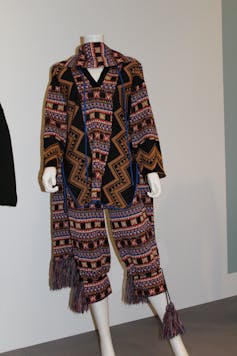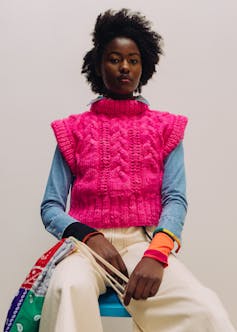Chunky knit piece that uses the traditional Aran technique in a modern way. Image by Alexander James
Knitwear: Chanel to Westwood review – diversity of knitted fashion
The exhibition consists of a vast array of knitted garments from the collection of Cleo and Mark Butterfield, owners of C20 Vintage fashion.
Chunky knit piece that uses the traditional Aran technique in a modern way. Image by Alexander James
The exhibition Knitwear: Chanel to Westwood is a powerful, evocative display of knitted history at Edinburgh’s Dovecot Studios. Once a unique tapestry studio in Edinburgh’s Old Town, it’s now a welcoming venue for contemporary arts, crafts and design.
The exhibition consists of a vast array of knitted garments from the collection of Cleo and Mark Butterfield, owners of C20 Vintage fashion. Their archive is frequently used and referenced by fashion and costume designers and major brands, as well as loaned out for popular film and TV dramas.
The exhibition takes the audience on a unique journey that transcends obvious representations of knitwear, which might normally be associated with more well-known historical and contemporary examples. This offers an unexpected and more diverse perspective – unlocking a treasure trove of knitted pieces, many of which will be new to audiences.
Starting with an early-1900s knitted petticoat which could have been plucked from the rails of a contemporary fashion store, the exhibition opens with outstanding examples of Chanel (and Chanel-influenced) knitwear from the 1920s. Set chronologically, visitors can enjoy an engaging visual journey from knitted swimwear and Fair Isle jumpers to second world war-era “make do and mend” – highly topical in today’s debates on sustainability.
ALSO READ: Milan Fashion Week opens with celebrity stardust, industry growth
Following displays of American knitwear, 1950s cocktail glamour and 1960s crochet, the exhibition’s second gallery takes in futuristic approaches by Courrèges and the novelty knitwear of Fiorucci, before dashing from the 1970s to the present day via Biba, Comme des Garçons and Sonia Rykiel.
Here are three exhibits that stood out to me:
1. Bill Gibb suit
A standout piece, and even more so given its Scottish roots, is the stunning 1976 suit by Bill Gibb. The piece features a jacquard-style knit with a myriad of patterns and rich fields of vivid colour.

Gibb’s tunic and knickerbockers, set with a matching knee-length scarf, display the way that knit can express high-fashion luxury through elaborate design and timeless style. This outfit stands apart from other pieces in the exhibition, appearing to be a woven technique at first glance. On closer inspection, the intricate knit techniques become clear.
Gibb, an Aberdeenshire-born designer, worked closely with his then-partner Kaffe Fasset (Dovecot’s next exhibition concerns his work), producing exquisite textiles involving multiple colour combinations and patterns. Although he died aged only 44, Gibbs’s influence on contemporary knitwear and fashion is still acknowledged and admired by designers today, including John Galliano and Giles Deacon.
This is where the exhibition really excels – in the discovery of designers beyond the big brands, and in celebrating visionaries who might easily be forgotten among today’s myriad fast fashion options.
2. Vivienne Westwood’s art of the undone
I was drawn to the small display of jumpers by the late Vivienne Westwood that exemplifies the “art in the undone”. This style showcases loose, hand-knitted techniques that are transparent, worn-looking and almost threadbare in appearance, but secured in place by standard ribbed neck trims, waists and cuffs.
You can appreciate the rebelliousness in this knitwear that, like much of Westwood’s work, subverts the rules of fashion. The “undone” look belies their technical accuracy and supreme production. A historically important and poignant example of the Westwood aesthetic and influence, these garments are still as fresh as the day they were produced and must be seen up close to be fully appreciated.
Their inclusion in this exhibition helps to convey how diverse knit techniques can be, and provides a visual celebration of the power of craft in fashion.
ALSO READ: Luxury knockoffs: How to spot even the best fake Chanel and Gucci
3. Scottish Knitwear Now

The exhibition concludes with a small display titled “Scottish Knitwear Now”, focusing on the work of hand knitwear designer Di Gilpin and her collaboration with the Paris/Glasgow label La Fetiche, directed by April Crichton (former design director for Sonia Rykiel).
Garments consist of a neon pink knitted top, a cream mini-skirt and an oversized cream jumper with bold colour stripes. Every piece is made in an Aran-style handknit – a traditional technique that many people will know from fishermen’s jumpers. These pieces are far from traditional, though, and offer a modern take on a classic knit – a fitting end to the exhibition.
While an interesting connection is made here with contemporary Scottish design and craft, I was left clamouring for more – which can only be a good thing. This hints at possibilities for a future exhibition to celebrate the vast wealth of Scotland’s knitwear design talent and brands, from Johnstons of Elgin and Barrie Knitwear to Green Thomas and Jennifer Kent.
Knitwear: Chanel to Westwood at Dovecot Studios closes March 11 2023
Article by: Mal Burkinshaw. Head of Design, The University of Edinburgh, The University of Edinburgh
This article is republished from The Conversation under a Creative Commons license. Read the original article.
